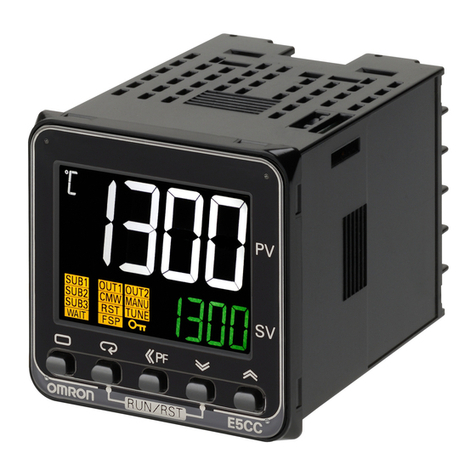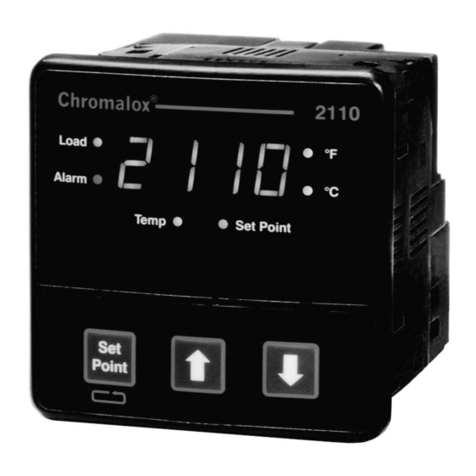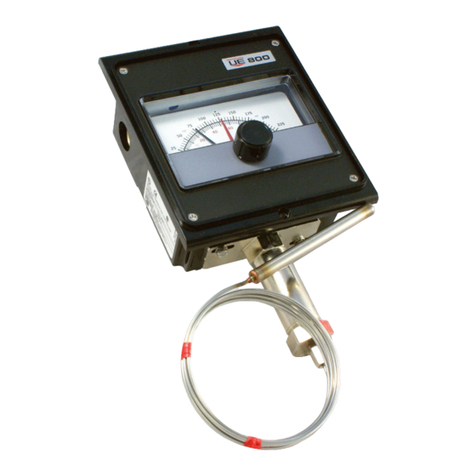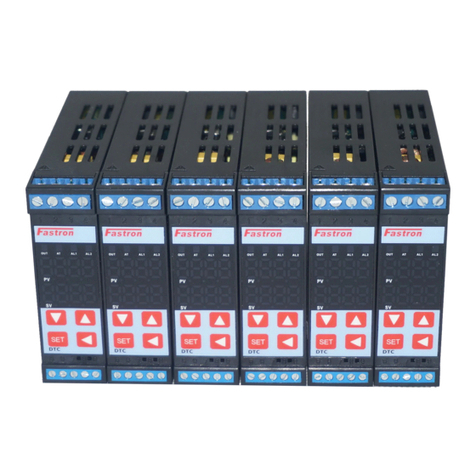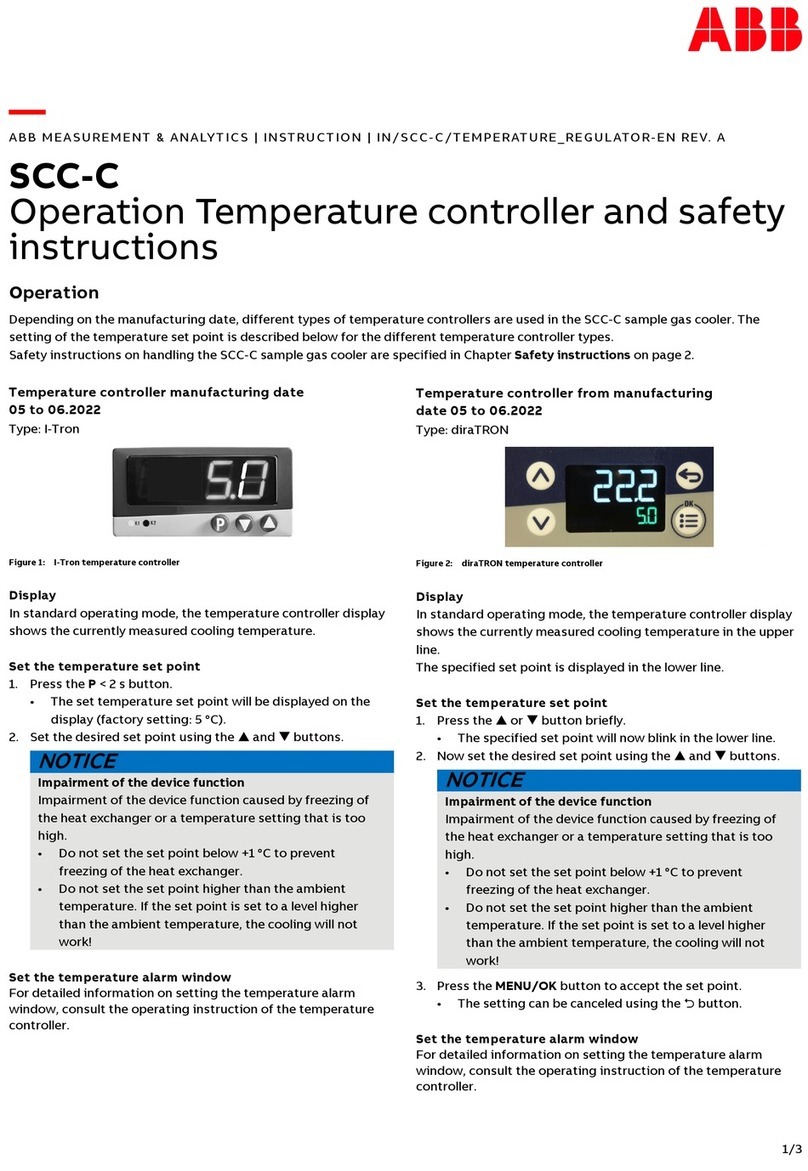United Process Versapro Owner's manual

Versapro
Temperature Controller
Installation and Operation
Handbook
Revision 1.11

VersaPro Temperature Controller Page 2
Copyright © 2013, United Process Controls Inc. All rights to copy, reproduce and transmit are reserved
Manual #: 022
Rev No: 1.11
Date: 30 October 2013
All trademarks used in this publication are duly marked and the sole property of their respective
owners. No attempt at trademark or copyright infringement is intended or implied.
COPYRIGHT
No part of this publication may be reproduced, transmitted, transcribed, stored in a retrieval system,
or translated into any language or computer language, in any form or by any means, electronic,
mechanical, magnetic, optical, chemical, manual, or otherwise, without prior written permission of
United Process Controls Inc.
DISCLAIMER:
The VersaPro is to be used by the industrial operator under his/her direction. United Process Controls
Inc. is not responsible or liable for any product, process, damage or injury incurred while using the
VersaPro. United Process Controls Inc. makes no representations or warranties with respect to the
contents hereof and specifically disclaim any implied warranties or merchantability or fitness for any
particular purpose.
For assistance please contact: United Process Controls Inc.
TEL: +1 513 772 1000 • FAX: +1 513 326 7090
Toll-Free North America +1-800-547-1055
www.group-upc.com

VersaPro Temperature Controller Page 3
Copyright © 2013, United Process Controls Inc. All rights to copy, reproduce and transmit are reserved
TABLE OF CONTENTS
TABLEOFCONTENTS.....................................................................................................................................................................3
1.SafetyandEnvironmentInformation....................................................................................................................................7
1.1Serviceandrepair........................................................................................................................................................................7
2.InstallationSafetyRequirements..........................................................................................................................................7
2.1SafetySymbol..............................................................................................................................................................................7
2.2Personnel.....................................................................................................................................................................................7
2.3Enclosureofliveparts..................................................................................................................................................................8
2.4Livesensors..................................................................................................................................................................................8
2.5Wiring..........................................................................................................................................................................................8
2.6PowerIsolation............................................................................................................................................................................8
2.7Earthleakagecurrent..................................................................................................................................................................8
2.8OverCurrentprotection...............................................................................................................................................................8
2.9Voltagerating..............................................................................................................................................................................9
2.10Conductivepollution...............................................................................................................................................................9
2.11Over‐temperatureprotection.................................................................................................................................................9
2.12Groundingofthetemperaturesensorshield........................................................................................................................10
2.13InstallationrequirementsforEMC........................................................................................................................................10
2.14Routingofwires....................................................................................................................................................................10
3VersaProFeatures..............................................................................................................................................................10
4Installation.........................................................................................................................................................................11
4.1Mounting...................................................................................................................................................................................12
5ProcessControlOptions.....................................................................................................................................................13
6ControlModes...................................................................................................................................................................13
6.1TimeProportioning(TP).............................................................................................................................................................13
6.2TimeProportioningDual(TD)....................................................................................................................................................14
6.3TimeProportioningwithComplement(TC)...............................................................................................................................14
6.4PositionProportioning(PP).......................................................................................................................................................14
6.5ON/OFF(OF).............................................................................................................................................................................14
6.6ON/OFFDual(OD).....................................................................................................................................................................15
6.7ON/OFFwithComplement(OC)................................................................................................................................................15
6.8DirectCurrentOutput................................................................................................................................................................15
6.9DirectorReverseControlAction................................................................................................................................................16
7Alarms...............................................................................................................................................................................16

VersaPro Temperature Controller Page 4
Copyright © 2013, United Process Controls Inc. All rights to copy, reproduce and transmit are reserved
7.1ProcessAlarms...........................................................................................................................................................................17
OFF.................................................................................................................................................................................................17
FullScaleHI....................................................................................................................................................................................17
FullScaleLO....................................................................................................................................................................................17
DeviationBand...............................................................................................................................................................................17
DeviationHigh................................................................................................................................................................................17
DeviationLow.................................................................................................................................................................................17
OutputHigh....................................................................................................................................................................................17
OutputLow.....................................................................................................................................................................................18
Fault................................................................................................................................................................................................18
Time................................................................................................................................................................................................18
Start................................................................................................................................................................................................18
Soak................................................................................................................................................................................................18
7.2AlarmAction..............................................................................................................................................................................18
7.3AlarmDelayTimes.....................................................................................................................................................................19
7.4DiagnosticAlarms......................................................................................................................................................................19
8SerialInterface...................................................................................................................................................................20
9FrontPanelOperation........................................................................................................................................................21
9.1EnterKey....................................................................................................................................................................................22
9.2RemoteKey................................................................................................................................................................................22
9.3SetupKey...................................................................................................................................................................................22
9.4DualKeyFunctions....................................................................................................................................................................31
StartingProbeTests.......................................................................................................................................................................31
StartTimer......................................................................................................................................................................................31
EditTimer.......................................................................................................................................................................................31
MonitorMode................................................................................................................................................................................31
10DigitalInputEvent..............................................................................................................................................................32
OFF.................................................................................................................................................................................................32
PROB...............................................................................................................................................................................................32
AUTO(controlleronly)....................................................................................................................................................................32
rEn(controlleronly).......................................................................................................................................................................32
ACK.................................................................................................................................................................................................32
PrOC(controlleronly).....................................................................................................................................................................32
Strt(controlleronly).......................................................................................................................................................................33
HOLd(controlleronly)....................................................................................................................................................................33
End(controlleronly).......................................................................................................................................................................33
11TimerFunction...................................................................................................................................................................34
11.1SettingtheTimer..................................................................................................................................................................34
11.2Time......................................................................................................................................................................................35
11.3GuaranteedStartTimer........................................................................................................................................................35
11.4GuaranteedSoakTimer........................................................................................................................................................36
11.5TimerAlarmBehavior...........................................................................................................................................................36
11.6TimerStateDiagram.............................................................................................................................................................36
12TimerSIOOperations.........................................................................................................................................................38

VersaPro Temperature Controller Page 5
Copyright © 2013, United Process Controls Inc. All rights to copy, reproduce and transmit are reserved
12.1ControllingtheTimerRemotely............................................................................................................................................39
13Tuning................................................................................................................................................................................40
13.1Whatistuning?.....................................................................................................................................................................40
14ScalingAnalogInputs.........................................................................................................................................................43
14.1LinearExample......................................................................................................................................................................43
14.2KeyboardFunctionduringInputSlope..................................................................................................................................43
15ScalingAnalogOutputs.......................................................................................................................................................44
16Calibration.........................................................................................................................................................................44
16.1CalibrationDisplaysandKeyboardOperation......................................................................................................................45
16.2PreparingforInputCalibration.............................................................................................................................................45
CalibrationoftheThermocoupleInput..........................................................................................................................................46
CalibrationoftheColdJunctionTemperature...............................................................................................................................46
CalibrationoftheAnalogOutputChannels...................................................................................................................................47
17Communications................................................................................................................................................................48
17.1Modbus.................................................................................................................................................................................48
RTUFraming...................................................................................................................................................................................48
AddressField..................................................................................................................................................................................48
FunctionField.................................................................................................................................................................................48
DataField.......................................................................................................................................................................................49
ErrorCheckField(CRC)...................................................................................................................................................................49
17.2MSIMessageProtocol..........................................................................................................................................................50
17.3InstrumentType‘U’CommandSet.......................................................................................................................................52
‘X’Command..................................................................................................................................................................................52
BlockCommands............................................................................................................................................................................54
MSIErrorCodes..............................................................................................................................................................................56
18TroubleshootingQuestions................................................................................................................................................57
18.1AnalogInputs........................................................................................................................................................................57
18.2ControlOutputs.....................................................................................................................................................................57
18.3DigitalCommunications........................................................................................................................................................58
18.4DisplayFunctions..................................................................................................................................................................58
18.5TimerFunction......................................................................................................................................................................58
19VersaproMonitorMode.....................................................................................................................................................59
19.1PrepareforConnection.........................................................................................................................................................59
19.2HowtoConnect.....................................................................................................................................................................59
19.3StartMonitorMode..............................................................................................................................................................60
19.4‘D’DisplayCommand............................................................................................................................................................61
19.5‘L’WriteFLASHtoRAMDefaults..........................................................................................................................................61
19.6‘K’WriteRAMtoEEPROM....................................................................................................................................................61

VersaPro Temperature Controller Page 6
Copyright © 2013, United Process Controls Inc. All rights to copy, reproduce and transmit are reserved
19.7‘J’DisplayEEPROMValues....................................................................................................................................................62
19.8‘S’StatusDisplay...................................................................................................................................................................62
19.9‘W’WriteRAMwithEEPROMorDataValues......................................................................................................................62
19.10‘X’ExitCommand..................................................................................................................................................................62
19.11ViewingStatusandMemory.................................................................................................................................................62
19.12LoadingDefaultValues.........................................................................................................................................................63
19.13Whatifanerroroccurs.........................................................................................................................................................64
20TechnicalSpecification.......................................................................................................................................................65
20.1Environmentalratings..........................................................................................................................................................65
20.2Equipmentratings.................................................................................................................................................................65
20.3General..................................................................................................................................................................................65
20.4Electricalsafety(pendingapproval).....................................................................................................................................66
21VersaproMemoryMap......................................................................................................................................................68

VersaPro Temperature Controller Page 7
Copyright © 2013, United Process Controls Inc. All rights to copy, reproduce and transmit are reserved
1. Safety and Environment Information
Please read this section carefully before installing the controller
This instrument is intended for industrial applications used in conjunction with Marathon Monitors zirconia
oxygen sensors and standard thermocouple types. It is assumed that any installation meets either CE
standards for industrial safety or NEC standard wiring practices. Failure to observe these standards or the
installation instructions in this manual may degrade the safety or electrical noise protection provided by this
instrument. It is the installer’s responsibility to ensure the safety and electrical noise compatibility of any
installation.
1.1 Service and repair
This controller has user replaceable fuses but no other user serviceable parts. Contact your Marathon
Monitors Service (800-547-1055) for repair.
Caution: Charged capacitors
Before removing an instrument from its case, disconnect the supply and wait at least two minutes to allow
capacitors to discharge. Failure to observe this precaution will expose capacitors that may be charged with
hazardous voltages. In any case, avoid touching the exposed electronics of an instrument when withdrawing it
from the case.
Electrostatic Discharge (ESD) Precautions
When the controller is removed from its case, some of the exposed electronic components are vulnerable to
damage by electrostatic discharge. Anyone who is not probably ground using an ESD wrist strap or in contact
with a ground while handling the controller may damage exposed electronic components.
2. Installation Safety Requirements
2.1 Safety Symbol
Various symbols are used on the instrument, they have the following meaning:
Caution, (refer to the
accompanying documents)
Functional earth
(ground) terminal
!
The functional earth connection is required for safety ground add to ground RFI filters.
2.2 Personnel
Installation must be carried out by qualified personnel.

VersaPro Temperature Controller Page 8
Copyright © 2013, United Process Controls Inc. All rights to copy, reproduce and transmit are reserved
2.3 Enclosure of live parts
To prevent hands or metal tools touching parts that may be electrically live, the controller should be installed in
an enclosure. The contacts on the rear of the instrument case or finger save but it is still possible for loose
wiring, or metal objects to come in contact with live terminal connections. It is recommended that power be
removed from the instrument connections before they are disconnected. However, instrument’s power
connector can be removed with power applied. Care should be taken that the connector does not come in
contact with any grounded object.
2.4 Live sensors
The dc inputs, dc logic, and dc outputs are all electrically isolated from chassis ground. If the temperature
sensor is connected directly to an electrical heating element then the inputs will also be live. The controller is
designed to operate under these conditions. However you must ensure that this will not damage other
equipment connected to these inputs and that service personnel do not touch connections to these terminals
while they are live. With a live sensor, all cables, connectors and switches for connecting the sensor and non-
isolated inputs and outputs must be mains rated.
2.5 Wiring
It is important to connect the controller in accordance with the wiring data given in this handbook. Take
particular care not to connect AC supplies to the low voltage sensor input or other low level inputs and outputs.
Only use copper conductors for connections (except thermocouple inputs) and ensure that the wiring for
installations comply with all local wiring regulations. For example, in the UK, use the latest version of the
wiring regulations, BS7671. In the USA use NEC Class 1 wiring methods.
2.6 Power Isolation
The installation must include a power isolating switch or circuit breaker. This device should be in close
proximity to the control actuator, and within easy reach of the operator. There is no means of disconnecting
power from the instrument other than removing the connectors from the rear of the instrument. It is
recommended that additional power disconnects are provided in the installation to remove power from these
connectors as well.
2.7 Earth leakage current
Due to RFI Filtering there is an earth leakage current of less than 0.5mA. This may affect the design of an
installation of multiple controllers protected by Residual Current Device, (RCD) or Ground Fault Detector,
(GFD) type circuit breakers.
2.8 Over Current protection
The instrument has an internal 3.15 Amp fuse (P/N MFU-3.15PCTT) for instrument power and 1 Amp fuses
(P/N MFU-1.0PCTT) for the control contacts and alarms. It is recommended that additional protection against
excess currents be used for loads exceeding this rating. Fusing and interposing relays should be added to the
control circuit if high current or large inductive loads are used.

VersaPro Temperature Controller Page 9
Copyright © 2013, United Process Controls Inc. All rights to copy, reproduce and transmit are reserved
2.9 Voltage rating
The maximum continuous voltage applied between any of the following terminals must not exceed 250VAC:
line or neutral to any other connection;
relay output to logic, dc or sensor connections;
any connection to ground.
The controller should not be wired to a three phase supply with an unearthed star connection. Under fault
conditions in this supply could rise above 264VAC with respect to ground and the product would not be safe.
Voltage transients across the power supply connections, and between the power supply and ground, must not
exceed 2.5kV. Where occasional voltage transients over 2.5kV are expected or measured, the power
installation to both the instrument supply and load circuits should include a transient limiting device.
These units will typically include gas discharge tubes, metal oxide varistors, and constant voltage transformers
help suppress voltage transients on the supply line due to lightning strikes or inductive load switching. Devices
are available in a range of energy ratings and should be selected to suit conditions at the installation.
2.10 Conductive pollution
Electrically conductive pollution must be excluded from the cabinet in which the controller is mounted. For
example, carbon dust is a form of electrically conductive pollution. To secure a suitable atmosphere in
conditions of conductive pollution, fit an air filter to the air intake of the cabinet. Where condensation is likely,
for example at low temperatures, include a thermostatically controlled heater in the cabinet.
2.11 Over-temperature protection
When designing any control system it is essential to consider what will happen if any part of the system should
fail. In temperature control applications the primary danger is that the heating will remain constantly on. Apart
from scrapping the product, this could damage any process machinery being controlled or even cause a fire.
Reasons why the heating might remain constantly on include:
the temperature sensor becoming detached from the process;
thermocouple wiring becoming a short circuit;
the controller failing with its heating output constantly on;
an external valve or contactor sticking in the heating condition;
the controller setpoint set too high.
Where damage or injury is possible, we recommend fitting a separate over-temperature protection unit. Factory
Mutual requires that any over temperature device use an independent temperature sensor, which will isolate
the heating circuit.
Please note that the alarm relays within the controller will not give protection under all failure conditions. This
instrument is not suited for over temperature protection and should not be used as a safety device.

VersaPro Temperature Controller Page 10
Copyright © 2013, United Process Controls Inc. All rights to copy, reproduce and transmit are reserved
2.12 Grounding of the temperature sensor shield
In some installations it is common practice to replace the temperature sensor while the controller is still
powered up. Under these conditions, as additional protection against electric shock, we recommend that the
shield of the temperature sensor be grounded at one end of the wire. Do not rely on grounding through the
framework of the machine.
2.13 Installation requirements for EMC
To ensure compliance with European EMC directives certain installation precautions are necessary as follows:
When using relay outputs it may be necessary to fit a filter suitable for suppressing the emissions. The filter
requirements will depend on the type of load. For typical applications such as Schaffner FN321 or FN612
line filters or equivalents.
If the unit is used in table top equipment which is plugged into a standard power socket, it is likely that
compliance to the commercial and light industrial emissions standard is required. In this case, to meet the
conducted emissions requirement, a suitable mains filter should be installed. Recommended filters would
be Schaffner types FN321 and FN612 or equivalents.
2.14 Routing of wires
To minimize the pick-up of electrical noise, the wiring for low voltage dc and particularly the sensor input
should be routed away from high-current power cables. Where it is impractical to do this, use shielded cables
with the shield grounded at one end.
3 VersaPro Features
The VersaPro is a single loop process controller / monitor has the following capabilities:
24 bit Sigma-Delta ADC for thermocouple with cold junction compensation.
Two (2) 4-20 milliamp outputs for control or chart recorder.
Sixteen character LCD with two four-digit LED segment displays.
Two (2) Form A control contacts. (controller)
Two (2) Form A alarm contacts.
PID control modes. (controller)
Serial Communication with Marathon Monitors or Modbus Protocol.
EEPROM stores setup and calibration values.

VersaPro Temperature Controller Page 11
Copyright © 2013, United Process Controls Inc. All rights to copy, reproduce and transmit are reserved
4 Installation
The VersaPro instrument is designed for up to 1/8" panel mounting in a DIN standard opening of 3.62" square
(adapter panels available by special order). Required rear clearance is 7.5” to allow for wiring.
As with all solid state equipment, the controller should be located away from excessive heat, humidity, and
vibration. Since the unit uses LED and LCD display devices, it should also be located so that direct sunlight
will not interfere with the display's visibility. The instrument requires 120/240 VAC 50/60 Hz and should not be
on the same circuit with other noise-producing equipment such as induction machines, large electrical motors,
etc. Signal wiring must be run separate from control wiring. It is suggested that signal wiring at the rear
terminals of the instrument be routed in one direction (up or down) while the AC power wires are routed in the
opposite direction.
The following figure shows the rear terminals locations on the rear of the VersaPro.
Figure 1 VersaPro Rear Panel
The following figure shows a typical wiring schematic for the Versapro temperature controller.

VersaPro Temperature Controller Page 12
Copyright © 2013, United Process Controls Inc. All rights to copy, reproduce and transmit are reserved
Figure 2 Wiring Schematic
4.1 Mounting
To mount the instrument in a control panel, a hole must be cut 3.62" square in the necessary location on the
panel. The following procedure should be followed to mount the VersaPro in the panel.
1) Insert the unit into previously cut out 3.62" square hole in panel.
2) While supporting unit, insert one clamping bracket into the groove on the bottom of unit, and then install
the 6-32 set screw.
3) Repeat step 2 for the top of the unit.
4) With a HEX KEY wrench, alternately tighten the screw on either side of instrument to a torque of six in.-
lbs. Insure rigidity of mounting. DO NOT OVER TIGHTEN. This can wrap the instrument enclosure
and make removal difficult.
To remove the instrument from the panel, reverse the above procedures.

VersaPro Temperature Controller Page 13
Copyright © 2013, United Process Controls Inc. All rights to copy, reproduce and transmit are reserved
5 Process Control Options
The Versapro is configured to perform as a single loop PID controller for a specific process. This instrument is
setup as an oxygen controller.
Table 1 Instrument Control Options
Function Description
Temperature Uses the temperature signals from a thermocouple to control to
temperature setpoint.
Linear Input A Uses the millivolt signal from a linear sensor connected to terminals
+TC / -TC
Linear Input B Uses the millivolt signal from a linear sensor connected to terminals
+MV / -MV
6 Control Modes
The VersaPro controller provides:
Time Proportional Single (TP)
Time Proportional Dual (TD)
Time Proportional Compliment (TC)
Position Proportioning (PP)
On/Off (OF)
On/Off Dual (OD)
On/Off Compliment (OC)
Direct Signal Output (4-20mA)
The instrument controls with two control contacts or direct 4-20mA output from two analog output channels.
The control function can be set to direct acting or reverse acting.
Direct acting increases the output control signal to increase the process. Reverse acting decreases the output
control signal to increase the process.
6.1 Time Proportioning (TP)
Time proportioning adjusts the duty cycle of the control device to maintain control. This is usually done with
solenoid valves controlling the flow of a trim gas or addition air to the process. The control loop percent output
is the percentage of the ON time relative to total cycle time. The cycle time is the ON time plus OFF time.
For example if the control loop percent output is 34% and the cycle time is 10 seconds, then the ON time
would be 3.4 seconds and the OFF time would be 6.6 seconds. The selection of the proper cycle time is a
tradeoff between excess wear and tear on the solenoid valve with short cycle times or oscillation of the control
process using long cycle times. Only the first control contact is used in this mode.

VersaPro Temperature Controller Page 14
Copyright © 2013, United Process Controls Inc. All rights to copy, reproduce and transmit are reserved
6.2 Time Proportioning Dual (TD)
This mode is used when there are two processes to control that have complementary effects; like heat and
cool. The time proportioning dual mode uses two control outputs; one for heat and one for cool. There is
never a time when both outputs are on simultaneously. The control loop computes a percent output from -100
to +100%. When positive, the proportioning action applies to the forward output. When negative the
proportioning action applies to the reverse output.
6.3 Time Proportioning with Complement (TC)
This mode is identical to the time proportioning mode except that both control outputs are used. The second
control output is the complement of the first. That is when the first output is ON then the second is OFF and
vice versa. This mode is used with single action motorized valves that open quickly when a voltage is applied
to one terminal and close quickly when voltage is applied to the other terminal.
6.4 Position Proportioning (PP)
This mode is used with motorized valves that do not have slidewire feedback. This mode is sometimes
referred to as "bump" mode because it "bumps" the valve slightly more open or closed. This mode uses both
control outputs; one to drive the motor forward (open) and the other to drive it reverse (closed). The control
output is the difference between the new percent output and the last percent output. If the difference is
positive than the valve motor is driven open for that percentage of the cycle. If negative it is driven closed by
that percentage of the cycle time.
For example if the new percent out is 60% and the old was 45% then the motor is driven open for 15% of the
cycle time. If the cycle time is set to the time that the motor takes to move from fully closed to fully open, then
the flow is theoretically increased by 15%. Two special cases exist. If the control output is computed at 100%
then the motor is driven continuously in the open direction. Likewise if the control output is computed as 0%
then the motor is driven continuously closed.
There is a built in deadband for this control based on the length of the cycle time. The comparison between
the previous and current output values are made at the end of each cycle time. Faster comparisons can be
made by shortening the cycle time assuming that a 100% command output is a continuously close control
contact.
6.5 ON/OFF (OF)
ON/OFF control is exactly what it implies, the control action is either ON or OFF. With true ON/OFF control the
control output is ON whenever the process is below the setpoint value and OFF when the process is at or
above the process value. In many real world applications this simple control method will cause "contact
chatter" because of noisy signals which will switch the ON and OFF states rapidly. Also since the control
action does not turn OFF until the setpoint is reached, the process will overshoot due to lags in the control
action.
Marathon controllers incorporate two features that prevent these problems from occurring; hysteresis and
deadband. Hysteresis provides a delay between the control on point and the off point. Noise will not cause
the control output to “chatter” with this gap applied. Hysteresis is ±20% of the deadband value.

VersaPro Temperature Controller Page 15
Copyright © 2013, United Process Controls Inc. All rights to copy, reproduce and transmit are reserved
Deadband allows the process to deviate away from the setpoint by the width of the deadband before any
control action occurs. The deadband is adjusted through the Proportional Band in units of the displayed
setpoint value. The reset and rate values have no effect in ON/OFF control.
Let’s assume the process setpoint is 1500° with a proportional band of 5. This represents a deadband of 5°,
which is a band of ±5° around setpoint. The hysteresis is 1° of the setpoint or 20% of the deadband. The
output is turned on when the process drops below 1495° and turns off then it reaches 1499°.
The deadband controls the point where the control is turned on to correct any deviation from setpoint. The
hysteresis controls the point where the control is turned off to prevent overshoot or chatter.
6.6 ON/OFF Dual (OD)
This mode is similar to the time proportioning dual mode. The forward output acts as described in the ON/OFF
description above. The reverse output responds when the process is above the setpoint.
Using the temperature example with a proportional band (deadband) of 5, the heat contact would turn on when
the process is 1495° and will turn off when it comes to 1499°. Likewise the cool contact would turn on when
the process exceeds 1505° and will turn off when it drops to 1501°.
6.7 ON/OFF with Complement (OC)
This mode is exactly like ON/OFF control with the addition of a second control output. The second control
contact is turned ON when the first is control contact is OFF and vice versa.
6.8 Direct Current Output
The Versapro has two analog output channels that provide an isolated 4 to 20mA signal proportional to
selectable process values. The analog outputs can be configured to control the process by driving actuators
with a 4-20mA signal proportional to the calculated percent output of the PID loop. One or both output
channels can be used depending on the control mode selected. POUT selection drives the output signal
based on the HIPO and LOPO settings. If a Dual Time Proportioning control mode is selected with a HIPO =
100 and a LOPO = -100 then the output will be 4mA for –100%, 12mA for 0%, and 20mA for +100% output.
This setting is helpful if one actuator is driving two valves in a split configuration where air is fully opened at –
100% and gas is fully opened at +100% or both are closed at 0%.
It is possible to drive two actuators independently by setting on output to PO1 or PO2 where PO1 is the 0 to
+100% control output and PO2 is 0 to –100%. In this configuration both outputs are at the maximum (±100%)
with an output of 20mA.
It is also possible to drive one actuator with an output channel and a solenoid with a control contact. For
example, select PO1 for one analog output channel to drive a gas actuator and connect an air solenoid to the
reverse control contact. The percent output for both functions is determined by the PID settings. The cycle
time should be set to the stroke time required to fully open the actuator from a fully closed condition. Typical
stroke times would be 30 to 45 seconds.
The control contacts will still act as described in the previous modes even if the analog output channels are
being used.

VersaPro Temperature Controller Page 16
Copyright © 2013, United Process Controls Inc. All rights to copy, reproduce and transmit are reserved
6.9 Direct or Reverse Control Action
Control action determines how the output of the controller will react to effect a change on the process. The
control action is considered ‘direct’ if an increase in the output produces an increase in the process value. A
‘reverse’ control action would be when an increase in the output produces a decrease in the process.
For example oxygen would require a reverse acting control if the process component the instrument is
controlling is a trim gas. Increasing the trim gas will result in a decrease in the oxygen reading. It is
considered a direct acting control if the process component under control is additional air. Either process
would use the first control contact; it would just be activated above or below the process setpoint depending on
what is being added to the process.
7 Alarms
The instrument has two types of alarms, process alarms and diagnostic alarms. If an alarm has been selected
and conditions are such that the alarm becomes active, the instrument will display this condition on the center
LCD display. The alarms a numbered as Alarm 1 and Alarm 2. The various displays for active alarm
conditions would be displayed as shown below. N indicates the position of the alarm number, 1 or 2.
ALARM DISPLAY CONDITION ACTION
PROCESS HIGH Process alarm, contact assignable Full Scale High, Contact
automatically resets unless latched.
PROCESS LOW Process alarm, contact assignable Full Scale Low, Contact automatically
resets unless latched.
PROCESS HIGH OR LOW Process alarm, contact assignable Deviation Band,
Contact automatically resets unless
latched.
PROCESS HIGH Process alarm, contact assignable Deviation High, Contact automatically
resets unless latched.
PROCESS LOW Process alarm, contact assignable Deviation Low, Contact automatically
resets unless latched.
PROCESS HIGH Process alarm, contact assignable Power Output High, Contact
automatically resets unless latched.
PROCESS LOW Process alarm, contact assignable Power Output Low, Contact
automatically resets unless latched.
TIMER END Alarm contact assigned to TinE,
Strt, SOAK
Timer end alarm when the timer
counts to zero for Timer, Start, or
Soak timer modes. The contact
latches until reset by pressing the
Enter key or through the Input Event.
LLLL Display only Displays process value within display
range or exponent setting
HHHH Display only Displays process value within display
range or exponent setting
FLASH CSUM Fault alarm, contact assignable Reset instrument power. Return to
Marathon if error does not clear.
EEPROM CSUM Fault alarm, contact assignable Reset instrument power. Return to
Marathon if error does not clear.
KEYBOARD Fault alarm, contact assignable Reset instrument power. Do not push
any keys while instrument is powered
on. Return to Marathon if error does

VersaPro Temperature Controller Page 17
Copyright © 2013, United Process Controls Inc. All rights to copy, reproduce and transmit are reserved
ALARM DISPLAY CONDITION ACTION
not clear.
FLASH ERASE Fault alarm, contact assignable Programming error,
Reset instrument power, attempt
reload.
FLASH / EE SIZE Fault alarm, contact assignable Programming error,
Reset instrument power, attempt
reload.
TEMP OPEN Fault alarm, contact assignable Check thermocouple for open
condition or loose connection.
7.1 Process Alarms
The process alarms can be setup to activate either or both of the two alarm contacts provide on the VersaPro.
Nine user selectable modes are available. The Full Scale HI, Full Scale LO, Fault, and Probe alarms are
available in the monitor. Of the alarms listed are available in the controller.
OFF
Disables the alarm function and the alarm contacts
Full Scale HI
An alarm is generated any time the process value goes above the Full Scale HI alarm value. This alarm is
reset if the process falls below the alarm value or acknowledgement from the front panel or through the
event input (if configured).
Full Scale LO
An alarm is generated any time the process value drops below the Full Scale LO alarm value. The alarm
will arm once the process is measured above the alarm value. This alarm is reset with an
acknowledgement from the front panel or through the event input (if configured).
Deviation Band
An alarm is generated any time the process value goes above or below the band alarm setting. The alarm
setting is value of the band. For example, if a value of 10 is entered as the alarm value, an alarm is
generated if the process goes 10 units above or 10 units below the setpoint. Units are the process units
such percent or degrees. This alarm will not arm until the process is in-band of the setpoint.
Deviation High
An alarm is generated any time the process value goes above the band alarm setting. The alarm setting
is number of units allowed above setpoint. Units are the process units such percent or degrees. This
alarm will not arm until the process is in-band of the setpoint.
Deviation Low
An alarm is generated any time the process value goes below the band alarm setting. The alarm setting is
number of units allowed below the setpoint. Units are the process units such percent oxygen or degrees.
This alarm will not arm until the process is in-band of the setpoint.
Output High
An alarm is generated any time the control percent output exceeds the alarm value. The alarm setting is
maximum percent output allowed.

VersaPro Temperature Controller Page 18
Copyright © 2013, United Process Controls Inc. All rights to copy, reproduce and transmit are reserved
Output Low
An alarm is generated any time the control percent output drops below the alarm value. The alarm setting
is minimum percent output allowed.
Fault
An alarm is generated any time an open input occurs on the T/C input. The input is pull up to a maximum
value if no input is connected or if the input fails in an open circuit mode. The center display will indicate
which of these conditions has caused the alarm. The alarm process will also become active if any of the
listed hardware faults occur. The center display will indicate which of these conditions has caused the
alarm.
Time
This alarm setting is necessary for the timer function to work. The timer will only run if it is enabled in the
Ctrl Setup menu and a timer setpoint value other than zero has been assigned. This alarm setting allows
the timer to start running when it is activated at the Start Timer parameter in the Setpt key menu, when the
dual key combination Left Arrow and Enter keys are pressed, or if the Input Event has been configured for
Start and a contact closure occurs. The timer will start running as soon as it starts, independent of any
process values. See the Timer section for more details.
Start
This alarm setting is necessary for the timer function to work. The timer will only run if it is enabled in the
Ctrl Setup menu and a timer setpoint value other than zero has been assigned. This alarm setting allows
the timer to be activated from the Start Timer parameter in the Setpt key menu, when the dual key
combination Left Arrow and Enter keys are pressed, or if the Input Event has been configured for Start
and a contact closure occurs. The timer will start running as soon as the process level is above the alarm
value and will continue to run once it has started. See the Timer section for more details.
Soak
This alarm setting is necessary for the timer function to work. The timer will only run if it is enabled in the
Ctrl Setup menu and a timer setpoint value other than zero has been assigned. This alarm setting allows
the timer to be activated from the Start Timer parameter in the Setpt key menu, when the dual key
combination Left Arrow and Enter keys are pressed, or if the Input Event has been configured for Start and
a contact closure occurs. The timer will start running as soon as the process level is within the band
around setpoint determined by the alarm value. The timer will stop any time the process falls outside the
band limit. See the Timer section for more details.
7.2 Alarm Action
Each alarm can be configured to operate in several different modes. Each alarm can be configured as a
reverse (normally closed) contact. This mode is usually used for failsafe alarms that will open during an alarm
condition, fault, or power failure. Each alarm can also be configured as a direct (normally open) contact that
closes when an alarm condition occurs. In both cases the alarm will automatically clear if the alarm condition
is resolved.
Each alarm can also be configured for either reverse or direct latched conditions. In this mode the alarm
contact will remain active until an acknowledgement is received through the event port or by pressing the
ENTER key.

VersaPro Temperature Controller Page 19
Copyright © 2013, United Process Controls Inc. All rights to copy, reproduce and transmit are reserved
7.3 Alarm Delay Times
Each alarm can have delay ON, delay OFF, or both delays applied. Delays can be applied in increments of a
second, up to a maximum of 250 seconds. ON delays are helpful if a known upset in the process can be
ignored. This avoids nuisance alarms but still maintains an active alarm if the alarm condition persists
following the delay. OFF delays will hold the alarm contact active for a determined period of time once the
alarm condition has cleared. This can be helpful as an interlock to other process functions that may have to
recover following an alarm condition.
7.4 Diagnostic Alarms
A diagnostic alarm is shown on the instrument’s center display when a fault is detected in the internal
hardware during power up. These alarms included:
FLASH CSUM A fault has been detected in the Flash memory.
EEPROM CSUM A fault has been detected in the EEPROM.
KEYBOARD A key is stuck or was held down during power up.
FLASH ERASE This error may occur during instrument programming. The Flash memory may be
faulty. Retry programming; make sure the communications link to the instrument is
working properly.
FLASH / EE SIZE This error may occur during instrument programming. The Flash memory may be faulty.
Retry programming; make sure the communications link to the instrument is working
properly.
If either alarm contact is configured for a fault this alarm will engage if any of the above faults occur. The LCD
display will indicate the fault condition.
The front panel display will show 0000 if the process value is below the display resolution, or HHHH if the
process value is above the display resolution. It may be necessary to adjust the oxygen exponent and/or the
oxygen decimal point settings if these symbols occur.

VersaPro Temperature Controller Page 20
Copyright © 2013, United Process Controls Inc. All rights to copy, reproduce and transmit are reserved
8 Serial Interface
The VersaPro has a single RS-485 half duplex (two wire) communications port. This port can be configured
for either the Marathon protocol of Modbus RTU protocol. Baud rates and parities are selectable. The
Modbus protocol only uses a parity of none. See the section on communications for details on both of these
protocols.
The Versapro can be connected to networks with up to 128 similar devices. The differential transceiver used
in the Versapro meets or exceeds the TIA/EIA-485 and ISO/IEC 8482:1993(E) standards.
Connections for the serial interface should be connected to the following terminals:
TB-B 13 RTX +
TB-B 14 RTX –
All connections to any RS-485 bus should be made with shielded twisted pair wires using a low capacitance
cable specified for RS-485 multi-drop connections. The shield should be connected to ground on one end of
the wire run. Shield continuity should be maintained between wire segments. Each end of the network
should be terminated with a resistor that is close to the impedance of the cable. 100 to 120 ohms are typical
values. All connections to multiple instruments should be made in a daisy-chain fashion, from one instrument
to the next. A star network connection should never be used. A repeater should be considered for cable
distances beyond 3900 feet (1.2Km). Any network that is run between buildings should use repeaters with
optical fiber connections between buildings to avoid any noise spikes generated by lightning strikes.
Table of contents
Popular Temperature Controllers manuals by other brands
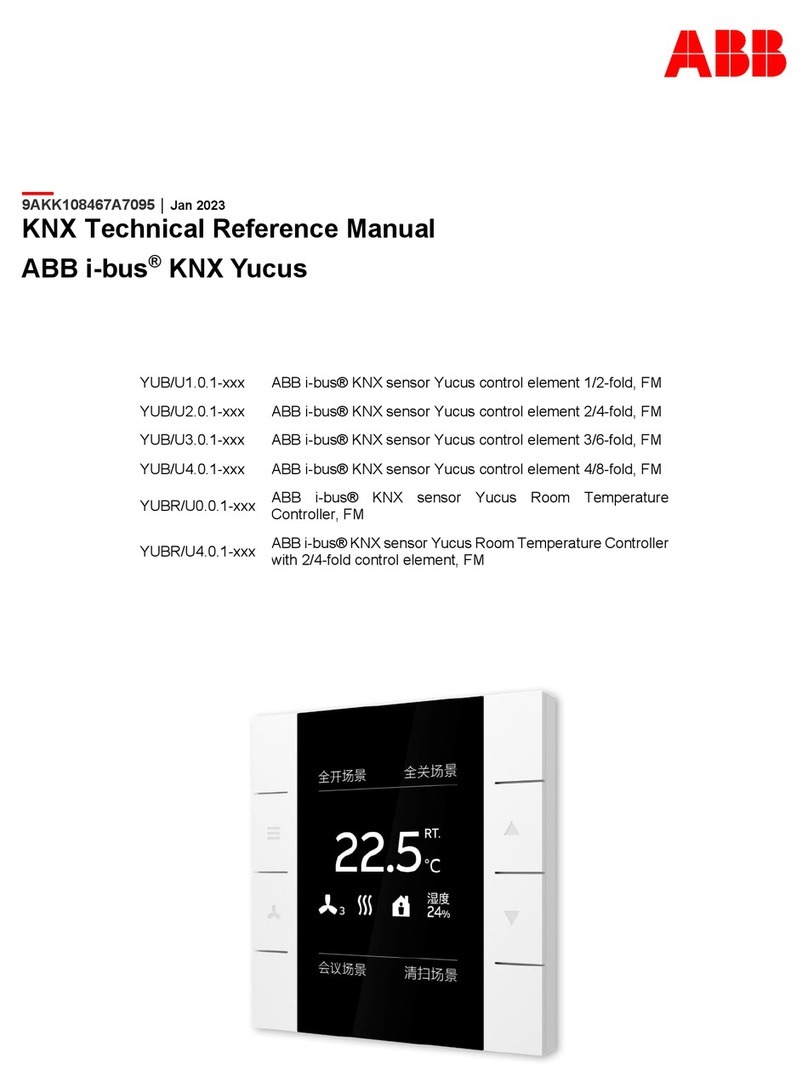
ABB
ABB i-bus KNX Yucus YUB/U1.0.1 Series Technical reference manual
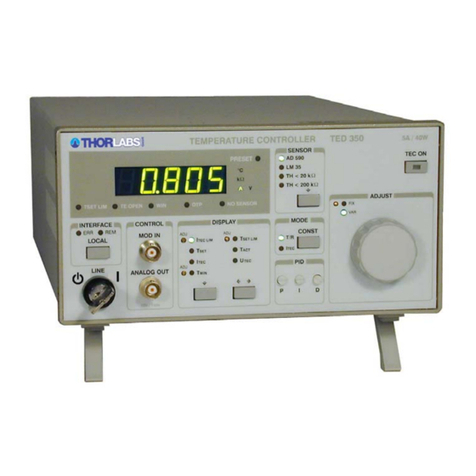
THORLABS
THORLABS TED350 Operation manual
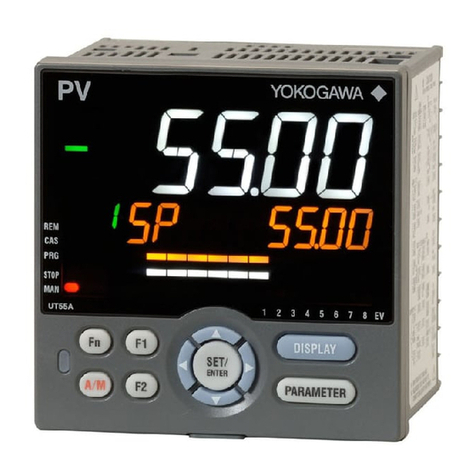
YOKOGAWA
YOKOGAWA UTAdvanced UT55A user manual
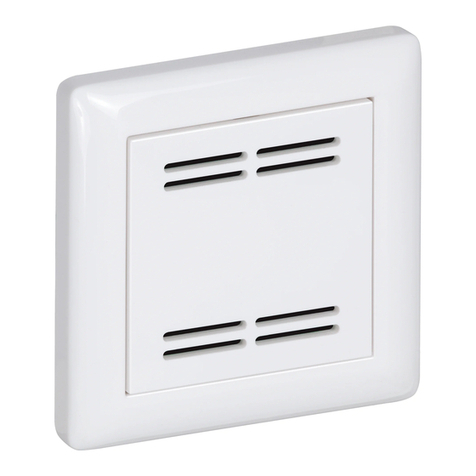
S+S Regeltechnik
S+S Regeltechnik HYGRASGARD FSFTM-Modbus Operating Instructions, Mounting & Installation
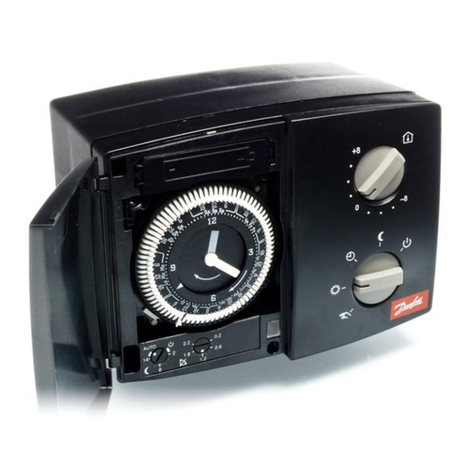
Danfoss
Danfoss ECL Comfort 100M User's guide and installation instructions

Secco
Secco SUPERCOOL-1000 user manual

Vaisala
Vaisala HUMICAP HMM212 user guide
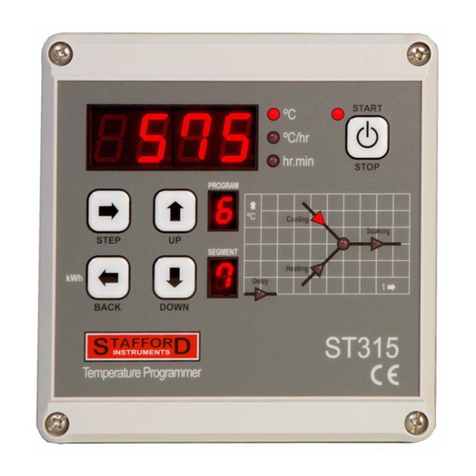
Stafford Instruments
Stafford Instruments ST315 User handbook

Palazzetti
Palazzetti GLH110 Installation, user and maintenance manual
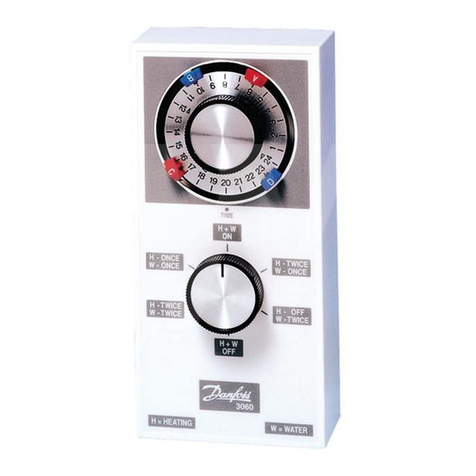
Danfoss
Danfoss 3060 Installation & user's instructions
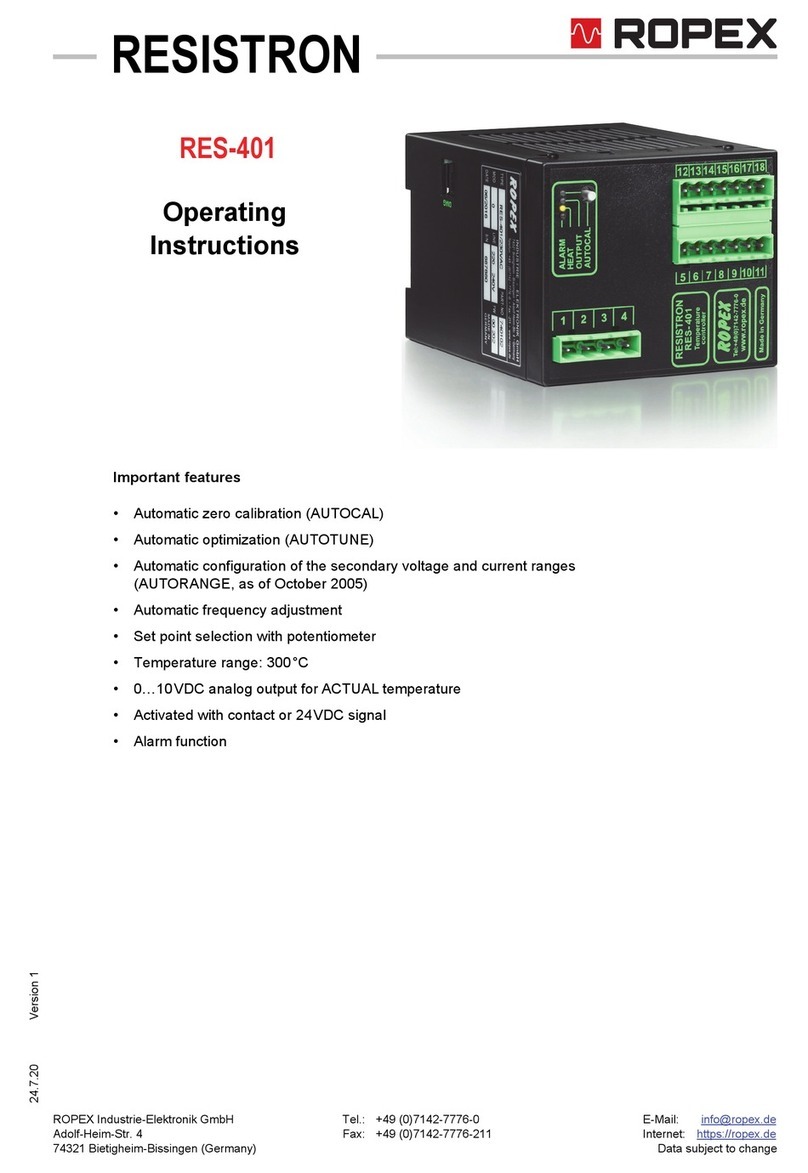
Ropex
Ropex RESISTRON RES-401 operating instructions

Elektronikbau- und Vertriebs
Elektronikbau- und Vertriebs Ceta 100 operating manual
